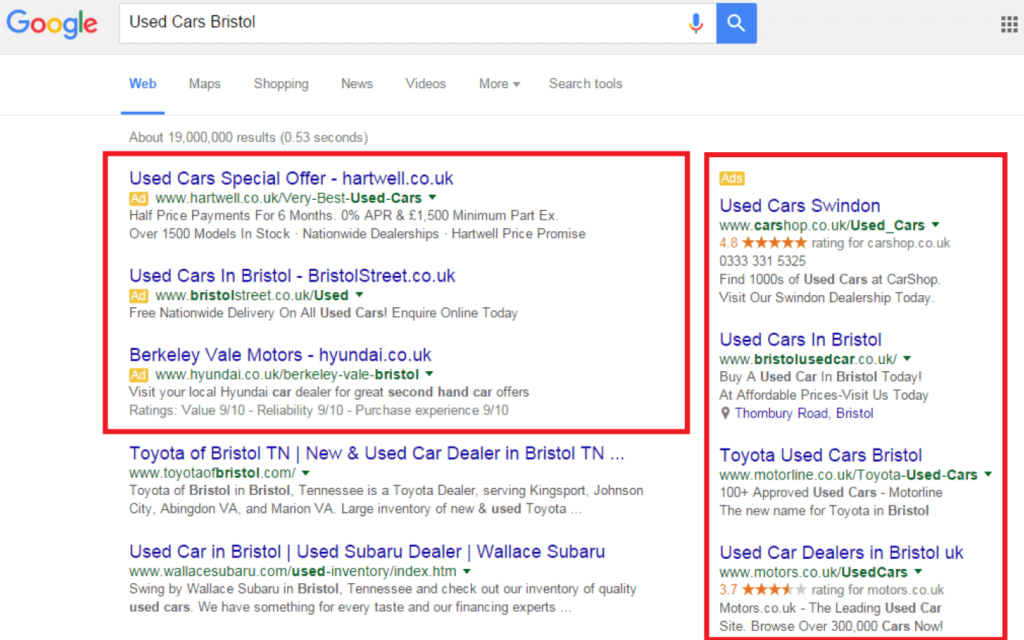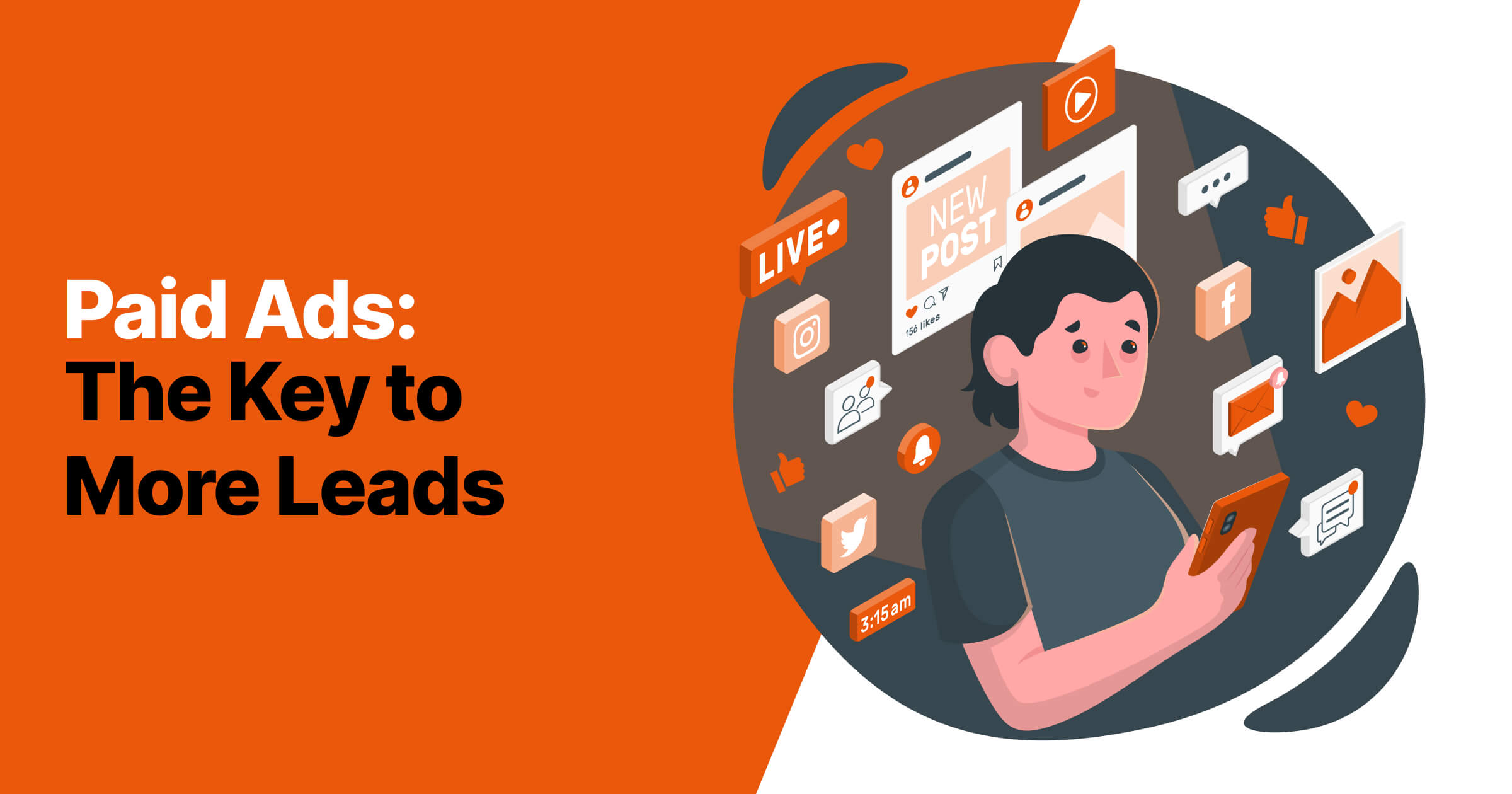Tapping into the Benefits of Paid Advertising
Paid advertising in digital marketing is used by advertisers who bid to participate in real-time auctions in order for their ads to be shown on a specific search engine, platform, or network. This online advertising model is used to bring traffic to a website and is often referred to as Pay-Per-Click (PPC) advertising.
It is a powerful yet often overlooked component of an effective digital marketing strategy. While organic marketing efforts like search engine optimization remain essential, paid advertising types deliver key benefits. In fact, various types of paid advertising made up over 41.8% of total digital ad spend in 2023 (source), and that number continues to climb as platforms like Google and Facebook make paid ads more customizable and affordable than ever.
In this article, we’ll explore some of the key benefits of paid advertising that make it critical for modern marketers: increased visibility and traffic, improved conversion rates, flexibility in targeting and creative testing, and metrics for optimization. Whether you’re running text, display, video or native ads, paid platforms provide unmatched opportunities for customer acquisition and revenue growth. By developing an integrated paid ads strategy leveraging the benefits paid advertising offers, brands can complement organic efforts to boost visibility, connect with customers, and drive measurable business results.
Table of Contents

Types Of Paid Advertising
There are many platforms that can be used for paid advertising such as Google Ads, Bing, Facebook, Instagram, X, and LinkedIn. On each of these platforms, different types of paid advertising options are available and these platforms could include one or multiple of the following ad types: search ads, display ads, video ads, native ads, and more. These various types of paid ads help advertisers connect with their target audience. The wide range of paid advertising types allow brands to build integrated strategies spanning different platforms to achieve awareness, engagement and conversion goals.
1. Search Ads
This is one of the most common types of paid advertising. The ads will appear at the top and at the bottom in a search engine results page, such as Google. Search ads don’t contain any visuals and contain only text. They appear on search engines according to the search terms used in the search bar. Advertisers will be charged each time the ad is seen/clicked on, depending on the bidding strategy used.

2. Display Ads
Display ads are another popular ad type used by many advertisers to promote brand awareness or a specific product. These ads contain an image/video and text. They are placed on search engine partner websites and are used to reach people that may be interested in your product or service.

3. Remarketing Ads
Remarketing ads are targeted at people who have visited your website previously but have not converted. This type of advertising presents you with the opportunity to get previous website visitors to re-engage with your products or services by sending them back to your website. The ads will focus on the product or service that the audience has previously viewed, reminding them to go back on to your website and make the purchase.

4. Shopping Ads
These ads are popular for advertisers who sell products and make it easier for people to find your products when they search for them on Google. The ads appear just under the search bar on search engines and show information such as a product image, name, price, and who the product is sold by.

5. Social Ads
This type of paid advertising is the most common due to the high number of users across social media networks. Social ads appear in social media feeds across different platforms. The ads are created on social media platforms such as Instagram, Facebook, and LinkedIn and are targeted to a specific audience. Social ads are beneficial for advertisers who are looking to grow their brand or get users to engage with their products or services on their website. Take a look at our Social Media Marketing for Businesses blog.

The Benefits of Paid Advertising
Paid ads form part of the most important channels in your digital marketing strategy but they need to be used accurately in order to see results and convert leads into customers.
Here are some benefits of using paid advertising:
💰The ads are affordable
Paid advertising is an affordable way to advertise or remarket your products or services to the right audience. It’s also easy to keep track of how much money is being spent, and in order to avoid overspending on ads, you can set a budget limit on your ad spend.
📊The ads are measurable
All paid advertising platforms offer users enough data to analyze the performance of the ads for users to make decisions on whether or not the ads are working.
📢Helps promote brand awareness
Most types of paid advertising can be used to promote your brand. Creating brand awareness helps your audience become familiar with your products and services by placing them on popular channels such as Google and Facebook, helping you keep up with the competition.
🎯Ads are targets to a more specific audience
When creating ads across the paid advertising platforms, you need to target the ads to an audience that will result in the ads being clicked on. These audiences are fine-tuned over time but in order for paid advertising to be effective, properly defining this target audience is crucial!
♻️Prospects are more likely to re-engage with your products or services
Using remarketing or retargeting ads in your paid advertising strategy allows you to re-engage with prospects that have previously visited your website. The timing and relevance of these ads will be what turns prospects into customers.
📈Easier to rank when compared to organic search
Paid advertising is a must-have for small startup businesses as this form of advertising increases traffic to the website. Websites take some time to rank organically, whereas paid ads provide you with the opportunity to appear higher on search engines from the start.

Developing A Paid Advertising Strategy
Before starting your paid advertising, a lot of time and research should be invested into creating your campaigns.
Having a strategy will help you do the following:
| Save time and money | spending some time on the strategy from the get-go will save you and your client a lot of money in the long run |
| Identify goals | you need to know exactly what you want to achieve with your paid advertising |
| Know your audience | you need to know who your paid ads will target and to understand your customer personas |
| Have a budget | this needs to be established in the strategy phase once you have determined your goals and audience |
| Decide which paid media channels to invest in | this will be the final step of your paid advertising strategy and will be based on the budget allocated to the paid advertising campaigns |
Essential Paid Advertising Metrics to Track
Paid advertising presents strategic opportunities for brands to effectively reach and engage potential customers, with many benefits to aid in acquiring and retaining consumers. However, maximizing the return and benefits from your advertising investment requires continuous optimization based on performance data. To enable refinement of your paid campaigns, you must actively monitor key quantifiable metrics:
- Impressions: How frequently your ads are being served to your target audience across selected platforms. High volumes indicate effective targeting.
- Click-through Rate (CTR): The percentage of impressions that result in clicks. Shows how compelling your messaging and creative is to drive engagement.
- Cost-per-Click (CPC): What you pay each time someone clicks your ad. Monitor to control spend.
- Conversions: How often users take your intended action post-click – purchases, downloads, signups etc. Shows optimization of funnel.
- Cost-per-Acquisition (CPA): Your customer acquisition cost based on spend needed to generate conversions. Lower is more efficient.
- Return on Ad Spend (ROAS): Total revenue earned per dollar of ad spend. Demonstrates clear profitability from paid advertising efforts.
By continuously analyzing these quantifiable metrics, you can shift budgets across campaigns, platforms and creatives to maximize reach, engagement, conversions and return from paid advertising. Optimization requires rigorous tracking.
Final Thoughts: Tapping into the Benefits of Paid Advertising
As platforms continue enhancing options for specific targeting, creative personalization, and cross-channel measurement, now is the time for brands to tap into paid advertising’s full potential. When combined strategically with organic efforts within a comprehensive digital marketing plan, paid media offers an adaptable way to reach valuable audiences and achieve tangible ROI.
From prospecting cold audiences to retargeting previous site visitors closer to conversion, data-driven paid ads help savvy marketers activate their first-party data across channels. Whether launching awareness campaigns or optimizing for higher-funnel events, a tested paid framework also enables agility in driving outcomes amid marketplace changes. By leveraging paid ads unique flexibility and measurement capabilities, forward-thinking brands can stay ahead of the curve.
Next Steps
Paid advertising is a broad form of advertising that offers numerous ways for you to reach your target audience. Having a strategy in place and knowing the benefits of paid advertising is important for any agency to adopt.
Read more about PPC advertising and digital marketing in some of the other blogs on our website.
More on the Importance of Paid Advertising in Digital Marketing
What are the main types of paid advertising?
The main types include search ads, display ads, remarketing ads, shopping ads, and social ads, each offering unique benefits for targeting different audiences.
How do search ads work?
Search ads appear on search engine results pages based on specific search terms. They are text-only and advertisers are charged based on views or clicks.
What makes display ads different from search ads?
Display ads contain images or videos along with text, and are placed on partner websites, not just search engines, providing a visual appeal for brand awareness.
What is the purpose of remarketing ads?
Remarketing ads target users who have previously visited your website but did not convert, encouraging them to re-engage with your products or services.
How do shopping ads benefit e-commerce businesses?
Shopping ads show product images, prices, and seller information directly in search results, making it easier for consumers to find and purchase products.
Why are social ads increasingly popular?
Due to the vast user base of social platforms, social ads allow businesses to engage with a large and diverse audience, promoting brand interaction and conversions.
What are the key benefits of paid advertising?
Paid advertising is affordable, measurable, increases brand awareness, targets specific audiences, re-engages prospects, and often ranks higher than organic search.
How can I set a budget for paid advertising?
Determine your goals and audience, then allocate a budget that aligns with your business size and campaign objectives, using platform tools to control spending.
Which metrics are crucial to track in paid advertising?
Important metrics include impressions, click-through rate (CTR), cost-per-click (CPC), conversions, cost-per-acquisition (CPA), and return on ad spend (ROAS).
How does paid advertising complement organic marketing?
While organic marketing builds long-term brand presence, paid advertising provides quicker visibility and targeted reach, working in tandem for comprehensive marketing.
Can small businesses benefit from paid advertising?
Yes, paid advertising offers small businesses a way to quickly reach potential customers and compete with larger companies, especially when organic growth is slower.
Why is targeting in paid advertising important?
Proper targeting ensures your ads reach the audience most likely to engage with your product or service, improving the efficiency and effectiveness of campaigns.
How does paid advertising help in brand awareness?
By placing your brand in front of a large, targeted audience across various platforms, paid advertising increases visibility and helps establish brand recognition.
What should be included in a paid advertising strategy?
A solid strategy should define goals, identify the target audience, set a budget, and choose the most appropriate paid media channels for your campaign.
How often should I review and adjust my paid advertising campaigns?
Regularly reviewing campaign performance allows for timely adjustments in strategy, targeting, and budget allocation, ensuring optimal results and ROI.
